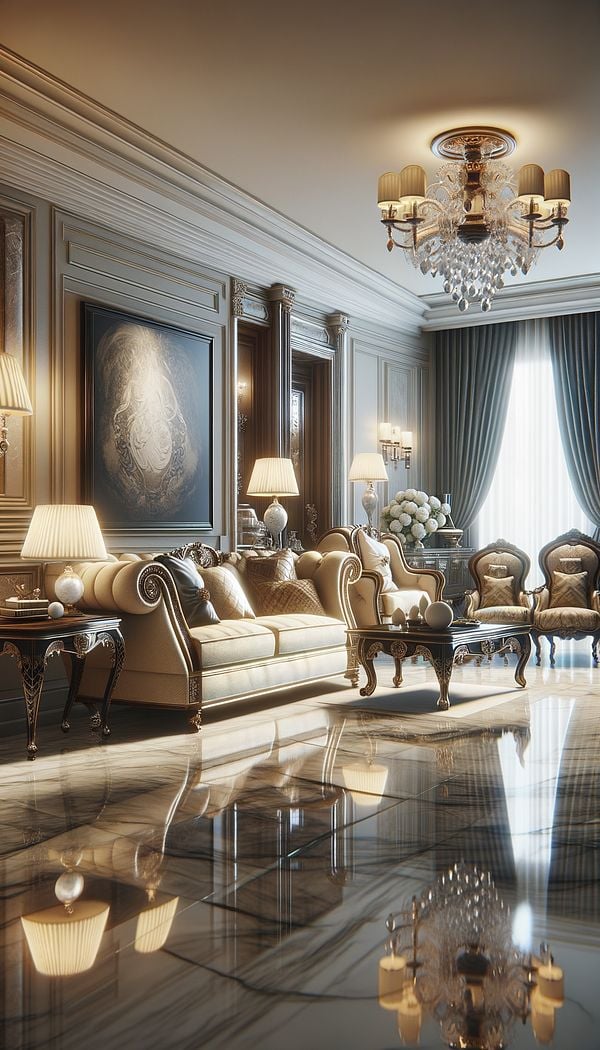What is Italian Finishing?
Italian Finishing refers to a high-quality, meticulous approach to surface finishing in interiors, known for its attention to detail and use of luxurious materials.
Description
Italian Finishing in the realm of interior design embodies the essence of luxury and meticulous craftsmanship. It is a term that not only refers to a style but also signifies a level of quality that is achieved through skilled craftsmanship, sophisticated design, and the use of premium materials. This type of finishing is distinguished by its incredible attention to detail, providing spaces with a polished and refined look that is unmistakably opulent.
The process of Italian Finishing can involve various techniques, including but not limited to, intricate stonework, polished plaster, high-end woodworking, and bespoke metalwork. Each of these techniques requires a high level of skill and precision, ensuring that every detail contributes to the overall elegance of the space. Moreover, Italian Finishing often incorporates the use of luxurious materials such as marble, granite, gold leaf, and fine woods, further enhancing the ambiance of sophistication.
While Italian Finishing is particularly revered in high-end residential projects, it also finds application in luxury commercial spaces, such as boutique hotels, exclusive restaurants, and designer retail stores. This finishing style celebrates the Italian heritage of expert craftsmanship and design innovation, offering a timeless appeal that merges tradition with contemporary design aesthetics.
Usage
Italian Finishing is synonymous with luxury in the interior design world. It is predominantly employed in high-end residential interiors to impart a sense of opulence and refinement. However, its applicability extends to luxury commercial spaces like boutique hotels, exclusive restaurants, and designer retail stores where the aim is to create an ambiance of sophistication and luxury. The distinction of Italian Finishing lies in its ability to elevate a space through meticulous craftsmanship and the use of premium materials.
FAQs
-
What makes Italian Finishing unique?
Italian Finishing is characterized by its focus on detail, craftsmanship, and the use of luxurious materials, setting it apart from other finishing techniques.
-
Can Italian Finishing be applied in modern interior design?
Yes, Italian Finishing is versatile and can be seamlessly integrated into both traditional and modern interior designs, adding a layer of sophistication and luxury.
-
What are the common materials used in Italian Finishing?
Common materials include marble, granite, fine woods, gold leaf, and polished plaster, each contributing to the luxurious finish that is indicative of this style.
Practical Application
To incorporate Italian Finishing into your design, focus on selecting high-quality materials and employ skilled craftsmen who specialize in detailed workmanship. Pay attention to the finishes of surfaces, from walls to furniture, ensuring that each element reflects the luxuriousness and detail-oriented approach characteristic of Italian Finishing. It's also important to balance the opulence with the overall design theme to achieve a cohesive and elegant aesthetic.
-
Architectural Elements199 articles
-
Design Styles478 articles
-
Decorative Techniques322 articles
-
Materials & Textiles360 articles
-
Wellington ChestA tall, narrow chest of drawers, often featuring a locking mechanism.
-
Contrasting WeltContrasting welt is a decorative edge detail used in upholstery and soft furnishings.
-
ModillionA Modillion is a decorative bracket used in classical architecture.
-
Hand DistressingHand distressing is a decorative technique used to give new furniture or materials an aged or weathered appearance.
-
Drawn To ScaleDrawn to scale refers to the replication of an object or space on paper or software, proportionately adjusting its dimensions to fit a specific size reference.
